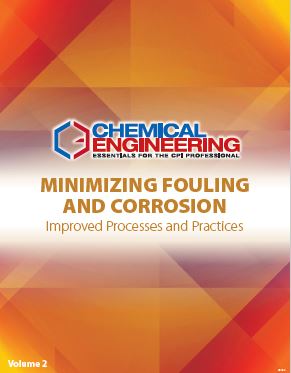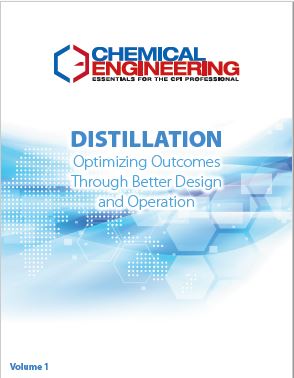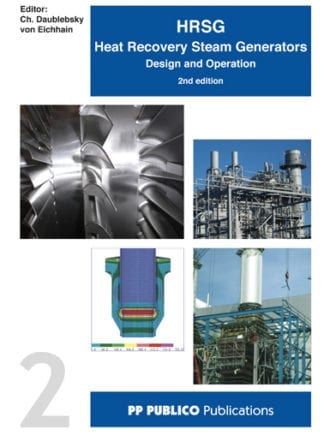Description
Minimizing Fouling and Corrosion — Volume 2: Improved Processes and Practices
The fight against corrosion and fouling is a never-ending battle for process operators throughout the chemical process industries (CPI). The articles in this Chemical Engineering Guidebook provide a wealth of practical engineering recommendations and best practices for effective corrosion monitoring and prevention in various types of CPI equipment components and systems.
Several topics focus on troubleshooting and inspection as well as provide tips for identifying and rectifying corrosion-related issues during plant revamps.
Articles center on selecting the most appropriate material of construction to withstand exposure to corrosive media. Also provided are tips for proper selection, handling and storage of acids, addressing fouling- and corrosion-related issues in cooling towers, filtration systems, wastewater-treatment plants and more.
This volume shares a wealth of maintenance, risk-reduction and reliability strategies.
238 pages, delivered in a PDF format.
Articles Include
Cooling Towers: Managing Tighter Water-Discharge Regulations
• Tightening regulations for cooling tower water discharge quality are requiring plant engineers to evaluate enhanced treatment options, sometimes including zero-liquid-discharge systems
Engineering for Plant Safety
• Early process-hazards analyses can lead to potential cost savings in project and plant operations
Cooling Towers: Estimate Evaporation Loss and Makeup Water Requirements
• Applying mass and energy balance calculations yields critical operating insight
Non-chemical Water Treatment
Overcoming Corrosive Processes with High-Alloyed Stainless Steels
• Advanced high-alloyed stainless steels with austenitic properties can address corrosion concerns in challenging phosphoric and nitric acid processes
What’s Corroding Your Control Room?
• Corrosion-induced failures are frequent in the electronics products used in control rooms, but proper environmental assessment, control and monitoring can help abate these concerns
Preventing Tank Corrosion
• Why a tank’s coating-application process makes all the difference
Plant Revamps and Turnarounds: Some Lessons Learned
• Although time is always precious, taking shortcuts and skipping standard procedures can be costly
Common Mistakes When Conducting a HAZOP and How to Avoid Them
• An important part of ensuring the success of a HAZOP study is to understand the errors that can cause the team to lose focus
The Relationship Between Materials Selection and Machining Processes
• An awareness of the impact of materials selection on the machining processes for small, complex components can affect overall end-product quality and costs
Corrosion Resistance Using Rock and Glue
• Low-cost, corrosion-resistant castings are being produced using epoxy and mineral aggregates
Pressure-Vessel Quality Control Requirements
• Understanding what is required for boiler and pressure-vessel manufacturers can help scheduling and cost assessments
Process Hazards Analysis Methods
Internal Corrosion Sampling
• Proper sampling and handling procedures are critical for supporting corrosion-management decision making
A New Approach to Corrosion Monitoring
• The impact of corrosion on assets and processes is great. Advances in technology allow engineers to assess corrosion in a whole new way, with real time monitoring and the ability to link deterioration with process conditions
Filtration and Separation During Chemical Process Operations: Avoid Common Errors
• The seven commonly made mistakes discussed here often lead to poor filtration and separation performance and many associated problems
Materials Selection in The CPI
• An overview of the many factors to be considered when selecting materials of construction
Field Troubleshooting 101 and How to Get the Job Done
• A major part of field work lies in troubleshooting problems: finding out why a system is not operating the way it is intended. This article provides guidelines for effective troubleshooting and contains many practical examples of their successful use
Why Bad Things Happen to Good Steam Equipment
• Accounting for an entire steam-trap population is crucial to avoiding safety incidents and suboptimal production — high-priority consideration must be given to steam-system management
Steel Corrosion
Materials Management — Evolving the Process for an Evolving Marketplace
• The case examples presented here show that proper planning, communication and execution of tasks can add value and reduce unintended negative consequences for many capital-intensive projects
Understanding New PPE Regulations
• The new European Union Personal Protective Equipment (PPE) Regulation explained, and what it means for the chemical process industries
Five Steps to Replacing Aged Heat-Transfer Fluid
• Follow these guidelines to help ensure efficient operation of heat transfer systems, and proper exchange and disposal of aged fluids
Beware of Flow- Accelerated Corrosion
• Operators of steam-generating systems should understand flow-accelerated corrosion and the potential problems it can cause
Corrosion in Flexible Burner Hoses
• Special care must be taken to avoid corrosion in flexible hoses for burners. This failure analysis illustrates the mechanism and provides recommendations
Performance Trends of Top Performers in the CPI
• Focusing on a ‘reliability culture,’ mechanical availability and optimum costs leads to top performance
Integrated Risk-Management Matrices
• An overview of the tools available to reliability professionals for making their organization the best-in-class
Implementing an ‘Integrity Operating Window’ Program
• An effective Integrity Operating Window (IOW) program — which establishes safe operating limits and acceptable limits of process variation before an asset begins to degrade — can help operators stay ahead of potential repairs and reduce risk
Storage Tanks: Heating and Cooling System Design
• Various heating or cooling options are described here, along with the factors and design parameters that need to be considered. A sample calculation regarding coils is included
Burner Inspection and Maintenance
• Burners and their components can be quite complex. Establishing maintenance and inspection best practices encourages long-term operational reliability
Safety in Sulfuric Acid Storage Tanks
• Commonly used in the CPI, sulfuric acid requires many special precautions to ensure its safe handling and storage
Large-Scale Fermentation Systems: Hygienic Design Principles
• Follow these tips to optimize systems that use microbial fermentation to produce biochemicals and biopharmaceuticals
Sampling for Internal Corrosion
Piping Codes: What the CPI Engineer Should Know
• An overview of the codes and standards that are most pertinent to chemical processing facilities
Coupler Technologies for Secure Chemical Handling
• Significant improvement in reducing fluid loss, optimizing flow paths and easing operation are among the advances in next-generation coupler technologies
Treating Wastewater for Industrial Reuse
• Secondary treated wastewater from municipal plants can be a water resource for industry. Important water characteristics and treatment options are discussed
Advantages Gained in Automating Industrial Wastewater Treatment Plants
• Process monitoring and automation can improve efficiencies in wastewater treatment systems. A number of parameters well worth monitoring, as well as tips for implementation are described
Odor Issues and Solutions for Wastewater Treatment
• Increasingly, wastewater treatment plants must address odors due to volatile contaminants. This guide provides an overview of odor causes and possible remedial actions
Strategies for Controlling Membrane Fouling
• In water treatment, the bulk solution, concentration polarization, permeate flux and membrane properties are some of the parameters that can be influenced
Modern Water-Treatment Challenges
• LNG and other facilities that are expanding due to the shale gas boom face specific challenges when it comes to ensuring the purity of the inlet and outlet water
Challenges of Drying Sticky Wastewater Sludge
• In wastewater-sludge drying and dewatering operations, many issues arise from the sticky properties of the sludge. Here are some insights to address them
Troubleshooting Tube-Deterioration Mechanisms in Direct-Fired Heaters
• A practical step-by-step guide for reducing future tube failure




